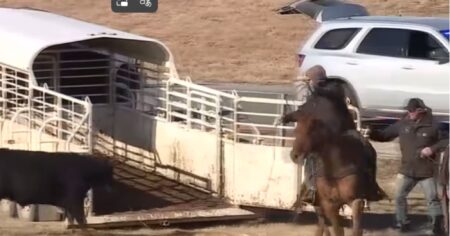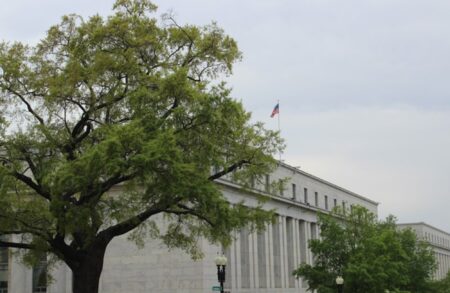After shunning U.S. soybeans this year, China pledged to buy 25 million tons of soybeans annually for the next three years as part of the U.S.-China trade deal. Agri-Pulse Newsmakers asked Minnesota Rep. Brad Finstad about the deal, his concerns about the November lapse in SNAP benefits due to the government shutdown, and year-round E15.
Plus, Barbara Patterson of Torrey Advisory Group and Ken Barbic of Invariant discussed how the lapse in SNAP benefits for the first time in program history could affect millions of Americans who depend on the program. They also discussed the implications of the U.S.-China trade deal, which keeps China’s soybean purchases level with, or even below, recent years.
Watch the Episode
Want to receive Newsmakers in your inbox every week? Sign up!
Read the Transcript
Please note: This transcript has not been edited.
Lydia Johnson: Welcome to Agri-Pulse Newsmakers, where we aim to take you to the heart of ag policy. I’m your host, Lydia Johnson. Our guest this week is Minnesota Congressman Brad Finstad, who joins us to discuss China’s commitment by U.S. ag products, the government shut and year-round E15.
But first, here’s this week’s headlines.
- President Donald Trump says he has secured a one-year agreement with China. It will be good for U.S. farmers. The administration, in turn, will lower tariffs on China and postpone Newport. Fees apply to Chinese made and operated ships. Tremendous amounts of soybeans and other farm products are going to be purchased immediately, Trump said on Air Force One. Treasury Secretary Scott Bessant confirmed Thursday that under the deal, Beijing has pledged to buy 12 million metric tons of soybeans this season and to keep import volumes to at least 25 million tons per year for the next three years. The agreement keeps Beijing’s purchases just below volumes in recent years. China bought about 26 million tons of soybeans in both 2023 and 2024, according to USDA’s Foreign Agricultural Service. But it also stressed that the purchasing commitments are a floor, not a ceiling.
- Lawmakers have been unable to reach an agreement that would keep the Supplemental Nutrition Assistance Program benefits from lapsing in November. More than two dozen U.S. states are suing the Trump administration in an attempt to prevent the pause in benefits. USDA suspended the aid, even though it has funds available that are sufficient to fund all or at least a substantial portion of November SNAP benefits, according to the lawsuit from more than two dozen states. Rollins and other administration officials say congressional Democrats are to blame for a possible lapse in SNAP benefits because of their opposition to the House passed stopgap spending bill.
- Beef imports from Argentina could rise by 4 to 5 times current levels after the Trump administration raised the annual import quota. Some lawmakers, including Congressman Jason Smith for Missouri, the chairman of the committee that oversees trade policy, sent a letter to AG Secretary Brooke Rollins and U.S. Trade Representative Jamison Greer. The decision to increase imports will undermine American cattle producers, weaken the US’s position, ongoing trade negotiations, and reintroduce avoidable animal health risks. The letter comes after all major industry groups representing U.S. cattle producers vocally oppose the plan. However, economists suggest the increase in imports isn’t expected to have a significant impact on cattle or beef prices after China has made no U.S. soybean purchases this marketing year.
A deal has been struck for China to commit to purchasing 25 million tons of soybeans annually. We asked Minnesota Congressman Brad Finstad about the impact of this purchase commitment.
Brad Finstad: Well, it’s an exciting time. I mean, obviously, we in farm country, I’m a farmer myself. You know, we want to farm for markets, not subsidies. And the opportunity for us to see the market move, to see more people buy our products, not less, is always an exciting time. You know, we have, needed to take a broad look. And, you know, there’s a lot of folks that have worked really hard on diversifying our trade partners over the years. China has consumed a lot of our soybeans traditionally. And as we’ve seen, the competition for soybean acres, grow across the globe, specifically with Brazil, we have to constantly be pushing and advancing, the great products that we produce in our country. And so for us to, you know, get back on the table with China and to, you know, kind of reset and level the playing field to give us an opportunity to compete, with Brazil and everyone else around the globe for our great products is it’s exciting.
Lydia Johnson: I’m curious. I mean, they’re calling this a deal, but that 25 million tons commitment that they made is, when you look at FAS, you know, pretty consistent with the purchases China has made in the last few years, isn’t it?
Brad Finstad: It is. But, what we need to continue to talk about is, you know, it’s not just China. China obviously is a big player specifically with soybeans, but, you know, some of the new trade deals that have been, signed just in the last couple of months with Japan, South Korea, the EU, the UK, Indonesia, like we have seen positive movement for us to diversify our buying partners, for soybeans and other egg products. So, you know, it is an exciting time for us again to diversify and create more market opportunity for our farmers.
Lydia Johnson: The government remains shut down and SNAP benefits, which many of your rural constituents rely on, are set to lapse in November for the first time in program history. How concerned are you about this?
Brad Finstad: I’m concerned, and obviously I hope your viewers know that I and my colleagues in the House voted to fund SNAP. We did that over 30 some days ago. That that bill sits in the Senate. And so, there has been this move in the Senate and quite frankly, in the Democrat Party right now, that their hate for President Trump is stronger than their love for country. And it’s unfortunate that, you know, recipients of SNAP, our military men and women, our federal employees are being weaponized for a, for a political point. And so, you know, I desperately ask the Democrats in the Senate, to put their love of country first, to stop the games. Real people are going to have real pain and real effects.
Lydia Johnson: The government shutdown and SNAP benefits are set to lapse in November. We asked Minnesota Congressman Brad Finstad if the lapse in SNAP benefits could put pressure on senators to begin negotiations to reopen the government.
Brad Finstad: You know, I sure hope it is, because, I mean, these, again, are real people’s lives that we’re that we’re talking about here. These are, you know, some of our low-income neighbors that that are, you know, trying to make ends meet. And SNAP is really intended to be a hand up, not a handout. It’s supposed to help people climb that ladder, out of poverty to help their families in tough times. But, you know, it’s not just SNAP. I mean, we have military men and women that are going to be going without getting paid. We have federal employees that are now missing a paycheck. And we have a lot of things in this country, a lot of momentum that we need to keep, keep rolling with to work on. And so, it’s not just shutting the government down and those benefits that are being lost, but we have halted Congress. We have stopped any progress on, you know, passing the remaining portions of the farm bill. We have stopped passing, you know, opportunities for new markets, for farm country, E15 year-round. I mean, there are so many things on the table that we have queued up and ready to go. And this is this is halting progress in our country.
Lydia Johnson: And you mentioned that year-round E15. I mean, we’re looking at great crop of corn, great crop of soybean here in the US this year. Do you think that, you know, the lack of markets you mentioned that trade deal with China. But, you know, this bumper crop really presents an opportunity to move the needle on biofuel policy.
Brad Finstad: It does. And again, you know, when we talk about, you know, making American energy great again, when we talk about being a powerhouse, when it comes to energy production in our country, E15 ethanol, biodiesel has to be a part of that conversation. We have homegrown energy opportunities, right? Right here in the upper Midwest. And, you know, we need to we need to take advantage of that. And moreover, we need to we need to just clarify once and for all E15 year round. And we need to do it from the legislative branch, because we have been at the whims of the EPA and the waivers and, and the uncertainty that that creates for producers and for farmers and for the market. And so, it is it’s Congress job to take that back and say, no, this is what it’s going to be. We’re going to pass this law and, create certainty in the, in the, in the marketplace certainty for our farmers, certainty for our energy producers, ethanol, biodiesel. And it’s just to me, it’s a no brainer. It is very bipartisan. We’ve been able to, you know, craft it in a way that’s very, bipartisan. And, and I think that’s good for, for policy. I think that’s good for civics. I think that’s good for our country, and it’s good for our farmers.
Lydia Johnson: And yeah, I’m curious, you mentioned pretty bipartisan, the legislation that you have in Congress. But the American Petroleum Institute recently withdrew their support for that legislation. I mean, they’re a big a big voice in the oil lobby, kind of that coalition between oil and agriculture. How do you think that that shifts the odds of the potential of getting year-round E15 this year?
Brad Finstad: Well, I can pull up letter after letter and statement after statement where they’ve actually supported this in the past. And, you know, this is politics. And this is, a wrinkle in the in the process. But, you know, I firmly believe talking to producers and quite frankly, talking to oil companies that do have interests in ethanol do have interest in, you know, homegrown energy, a lot of different options, not just oil, that, that have been supportive. So I think we can still, you know, keep the coalition together. I still think that we can, you know, rally up the votes that we need to, to pass E 15 year-round.
Lydia Johnson: Congressman, as we wrap up here, harvest is rolling on or even wrapping up in much of the Midwest. How are things looking for you and your family in Minnesota?
Brad Finstad: So, we’ve been very blessed. This is probably the best crop that I’ve been able to harvest on our farm. My dad and my father-in-law, who are the overseers and opinion-givers of our farming operation have said they have never seen corn like we were able to, to harvest. You know, we were blessed with over 250-bushel corn and over 60-bushel beans. And for us, that’s a good year. And so, you know, with the, crushing inputs that we faced for the last 4 or 5 years, and the, the market that’s been somewhat stale, that has that is really, you know, eaten up all the margins. And so, for us, the volume that we were able to get with, with bushels has been very, very welcoming. And we’re just we’re blessed.
Lydia Johnson: We’ll be back with more Newsmakers. But first, Parker Litterick looks at the increase in retail beef prices. And this week’s Ag by the Numbers.
Parker Litterick: Beef prices have hit record highs this year as cattle inventories dropped levels not seen since the early 1950s. The increase in the cost of beef comes as multi-year droughts led to loss grazing lands, leaving ranchers unable or reluctant to expand herd sizes. Now, consumers are paying more at the grocery store as the average price per pound continues to rise. This chart shows that as of August 2025, the price of boneless sirloin steak rose to $14.32 per pound, and ground beef rose to $6.32 per pound. The latest consumer price index released by the Bureau of Labor Statistics shows beef prices increased by another 1.2% in September and are now up 14.7% over the last 12 months. For Agri Pulse, I’m Parker Litterick.
Lydia Johnson: Welcome back. The government remained shut down and SNAP benefits are set to lapse in November. We’re joined by Barbara Patterson with Torrey Advisory Group and Ken Barbic with Invariant on our panel this week. Barbara, we’ll begin with you. What would a lapse in SNAP benefits mean for the millions of Americans who depend on this program?
Barbara Patterson: The lapse of benefits is a really big deal. Starting on November 1st, States stagger when people get benefits are some in a few cases, some recipients just received their October benefits last week. So, the impacts will not be felt the same by everyone. But most states start distributing their benefits starting on November 1st, and so the impacts will be felt in a lot of cases, starting with that first day of November on Saturday. This is, a tremendous impact to the 41 million people or so who, count on SNAP. And if you think about it, certainly if you’ve been paying attention to the news, there was expectations that the shutdown may last a while, but this is with relatively little notice. People started getting notice about their November benefits. Really, just in the last couple of days with the massive pick up and news coverage of this issue. So, there’s not even a lot of adjustments that can happen in your budget to accommodate for the loss of those benefits. We’ve seen some states step in and try to fill in the gap, but really we’re talking about pennies on the dollars in terms of those investments. And while they’re really I’m sure, appreciate it. They can’t fill the role that the federal government has been playing in SNAP. And certainly we’re saying this all with the expectation that that dynamic changes once the one big beautiful bill act, changes get implemented with SNAP as well. So, we’re seeing states trying to scramble to figure out how to fill in this budget, with just a few days notice on that. And it’s going to create a lot of challenges.
Lydia Johnson: And Barbara, very far reaching impacts of the SNAP program, but I’m curious, do you think that the lapse of benefits could be enough fuel for lawmakers to really begin these negotiations to reopen the government? What do you think that could look like?
Barbara Patterson: Yeah, I mean, I think if you are a student of history and you look at times of massive unrest, certainly a food insecure population is not a good population. That’s not helpful for civic discourse. It’s not a helpful environment to be in. I think it’s one of those areas that I would be paying a lot of attention to. And I think it’s no surprise to the folks that talk about food insecurity, that look at, you know, that food dynamics in our country, that’s no surprise that this might be the catalyst to open the government back up. This will have big impacts. And I know that legislators are hearing about it and hearing concerns. I’m hearing a real desire to get the government back open so that those SNAP benefits can start, can start flowing again.
Lydia Johnson: And Ken I, I want to bring you into the conversation. You were at USDA during the last government shutdown, during the first Trump administration. And, you know, now seeing all this play out, I’m curious your perspective there and then your perspective as well on, you know, how these negotiations could play out.
Ken Barbic: You know, there’s been some distinctions, you know, as you’ve seen the back and forth between, you know, some of the members on the Hill, the administration, between, you know, authorities and, you know, things that played out in the 2018, 2019 shutdown. And this one, you know, we have a dynamic here where we never had a, you know, a CR from the September 30th, time frame that was passed. So USDA is operating with, you know, different, dynamics. And they had in 2018 and 2019, which is their, you know, the rationale legally for why that contingency fund can’t be utilized this time versus, the flexibilities that were, in place, in 2018 and 2019. But, you know, I do think, you know, to Barbara’s points, you know, November 1st can be a significant date and, you know, it goes, you know, overstated in DC that, you know, we’re facing an unprecedented situation. But, you know, if you have a lapse in SNAP benefits going out, that truly is actually unprecedented. We’ve not seen that, in past shutdowns. And so I think, you know, the pressure points are going to change. You know, we’re watching the World Series this this week. And it feels like we are, in a lot of ways, entering the bottom of the ninth inning with this shutdown and whether we have, you know, another nine innings to go and an 18-inning game or whether we see the dynamics change where this is kind of the end game. You know, everyone’s watching that with November 1st date coming up.
Lydia Johnson: SNAP program participants are set to face new purchasing restrictions in select states beginning as early as January. We asked Barbara Patterson with Torrey Advisory Group what challenges she sees for these purchasing restrictions to be implemented.
Barbara Patterson: The SNAP restrictions conversation is not a new one. This is not a novel idea. It’s been talked about since the Food Stamp Act was, passed into law. What it does create, though, and is a lot of complications for not just the states to figure out, okay, what’s in and what’s out. What that list looks like, but also for the retailers to comply and communicate that with their customers. And we have to keep in mind that these are short term pilots. Most of them have been approved for just two years with their evaluations due 18 months after implementation. So, we’re talking about a year from next summer where we need to start understanding if these have impacts. This is not a broad-based change to SNAP. It doesn’t change the eligibility of different products for SNAP. These are pilot programs to demonstrate whether or not this is an effective, method for improving public health. And so there’s still a lot of questions around what those evaluations look like, how robust those are, how the data will be shared, as well as how the retailers will implement. And they’ve got quite a big challenge for them, especially if you’re thinking about retailers operating in multiple states that will have slightly different variances in terms of what is restricted and how those definitions are drafted.
Lydia Johnson: Ken I want to get your thoughts as well? China in the U.S. have struck a trade deal that, confirms purchasing commitments by China for soybeans as we look to the future. But many of those commitments are similar to purchases that China’s made from the U.S. in past years. I’m curious, from your perspective, what’s the impact of this trade deal?
Ken Barbic: That’s a great question. You know, very welcome news. Overnight out of the, the bilateral conversation that the president had, with the Chinese leader, you know, the 87 million metric ton, commitment through 2028. To your point, is going to restore, you know, a market if China follows through on that commitment. And, you know, I think right now there is a lot of pressure in farm country. You know, obviously soybeans is the forefront of this with, you know, to date, zero, you know, purchases having been made this season. And, you know, you’ve got a lot of pressure, not just from the trade perspective but from, you know, the input side. And, you know, other challenges that growers are facing. And it’s across the economy. I mean, the, you know, the input, you know, retailers are feeling pressure. You know, if their own. And I think that this deal is, is really, welcomed as a relief. If we see this come through as we, we go back to, to hopefully more historic, levels, in terms of that, trade dynamic with China. But I think that, you know, everyone in farm country and frankly, I think, you know, in conversations with folks in the administration, they see this as a first step. You know, China is one piece of a larger, of a larger puzzle in terms of, you know, farmer profitability and the agricultural economy. This administration has, you know, talked about the need to expand year round and 15, to expand, you know, domestic capacity for, for other demand creators through biofuels, synthetic aviation fuel, expanding the biomanufacturing economy so that, you know, while China will be a significant buyer, we will see other opportunities for demand creation in other markets that can be, avenues for our farmers to sell into. So I think this team, at, both USDA and the white House and USTR Treasury that, you know, the trade officials are actively engaged. But I think there’s an even broader consideration of all the various dynamics that go into ensuring, you know, the farmers have, not just markets internationally, but that they have, you know, markets here at home and that we see, the ability for farmers to, remain profitable and efficient, for years and decades into the future, regardless of a single, a single market like China.
Lydia Johnson: We’ll be back with more newsmakers. But first, Parker Litterick looks at the expected increases in Affordable Care Act health insurance premiums. And this week’s Map It Out.
Parker Litterick: Farmers are bracing for expected increases in health insurance premiums, as Affordable Care Act’s enhanced premium tax credits are set to expire at the end of the year. Estimates vary as experts don’t agree on how much more people will pay. However, there is broad agreement that the expiration will raise insurance premiums significantly for many Americans. KFF, a think tank, says that while only 8% of the general population buys health insurance on the individual market, about 27% of all farmers do. This map shows the estimated percent increase in average monthly payments across congressional districts. For a six year old couple making $85,000 a year if enhanced ACA subsidies expire. Based on the data, a couple living in Montana who use the ACA individual marketplace to get their insurance could see increases of as much as 400% in premiums. For some farmers, this could mean paying at least another $24,000 out of pocket for Agri-Pulse, I’m Parker Litterick.
Lydia Johnson: Thanks for joining us for another episode of Agri Pulse Newsmakers. The government remains partially shut down. The Senate committee will meet Wednesday to consider the nomination of Glenn Smith to be USDA Undersecretary for Rural Development. Tune in newsmakers next week and check our website any time for the latest developments on all things food, farm and fuel policy. For Agri-Pulse, I’m Lydia Johnson. Thanks for watching.
Agri-Pulse is a trusted source in Washington, D.C., with the largest editorial team focused on food and farm policy coverage.









:max_bytes(150000):strip_icc()/soybeans-down-7d23272bd031487b908c22b63639473a.jpeg)

:max_bytes(150000):strip_icc()/MayWheatRainDrops-1-731120a608ab4b9c8576aeff53d5ff5f.jpg)
